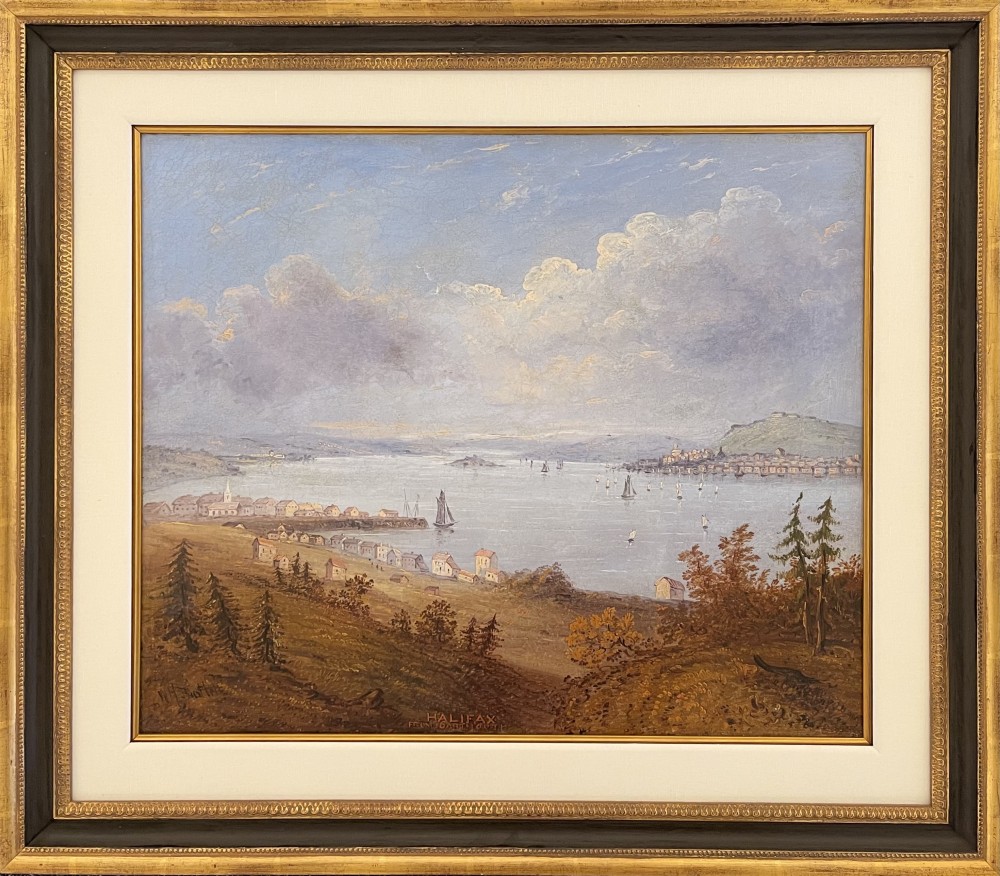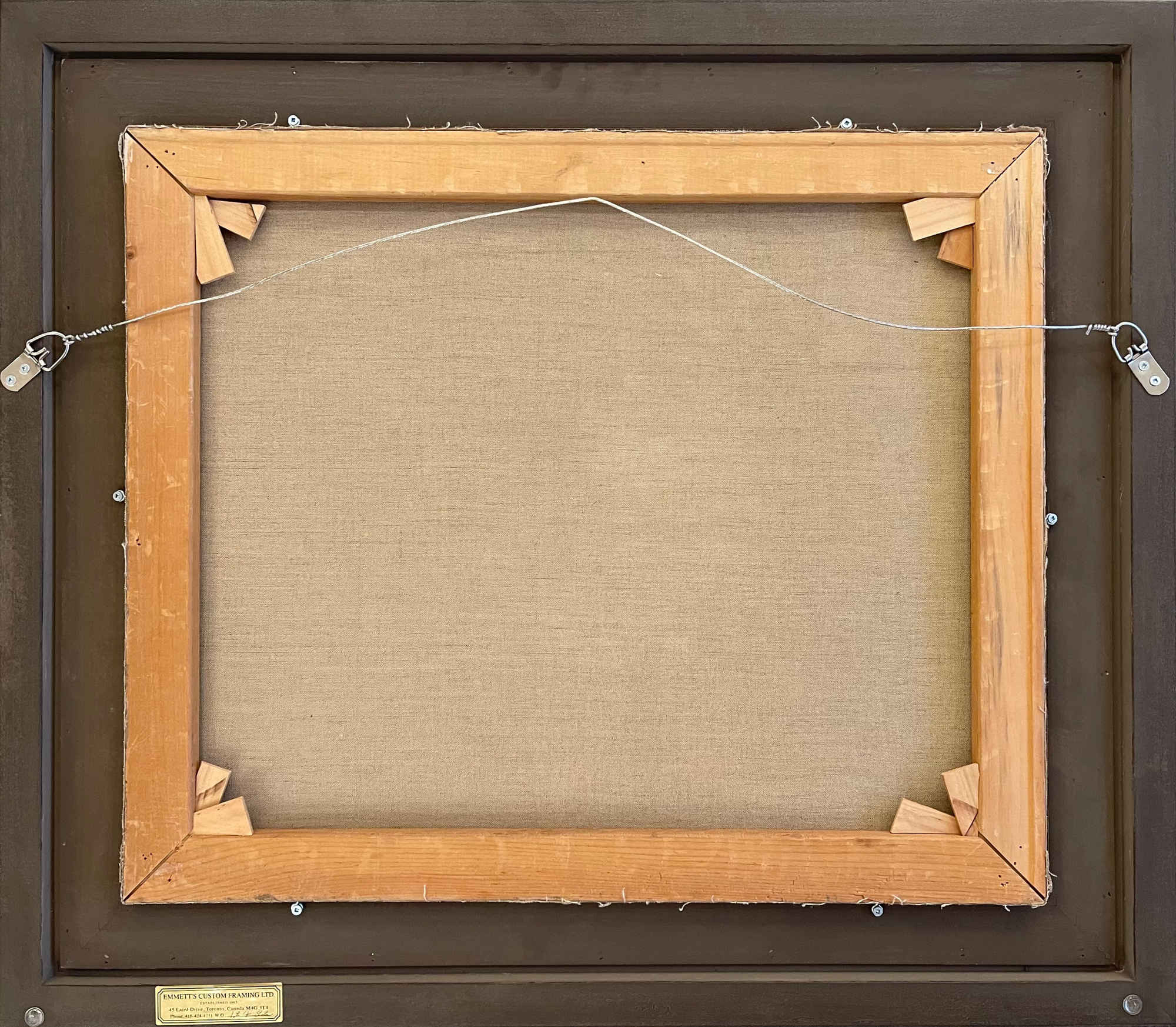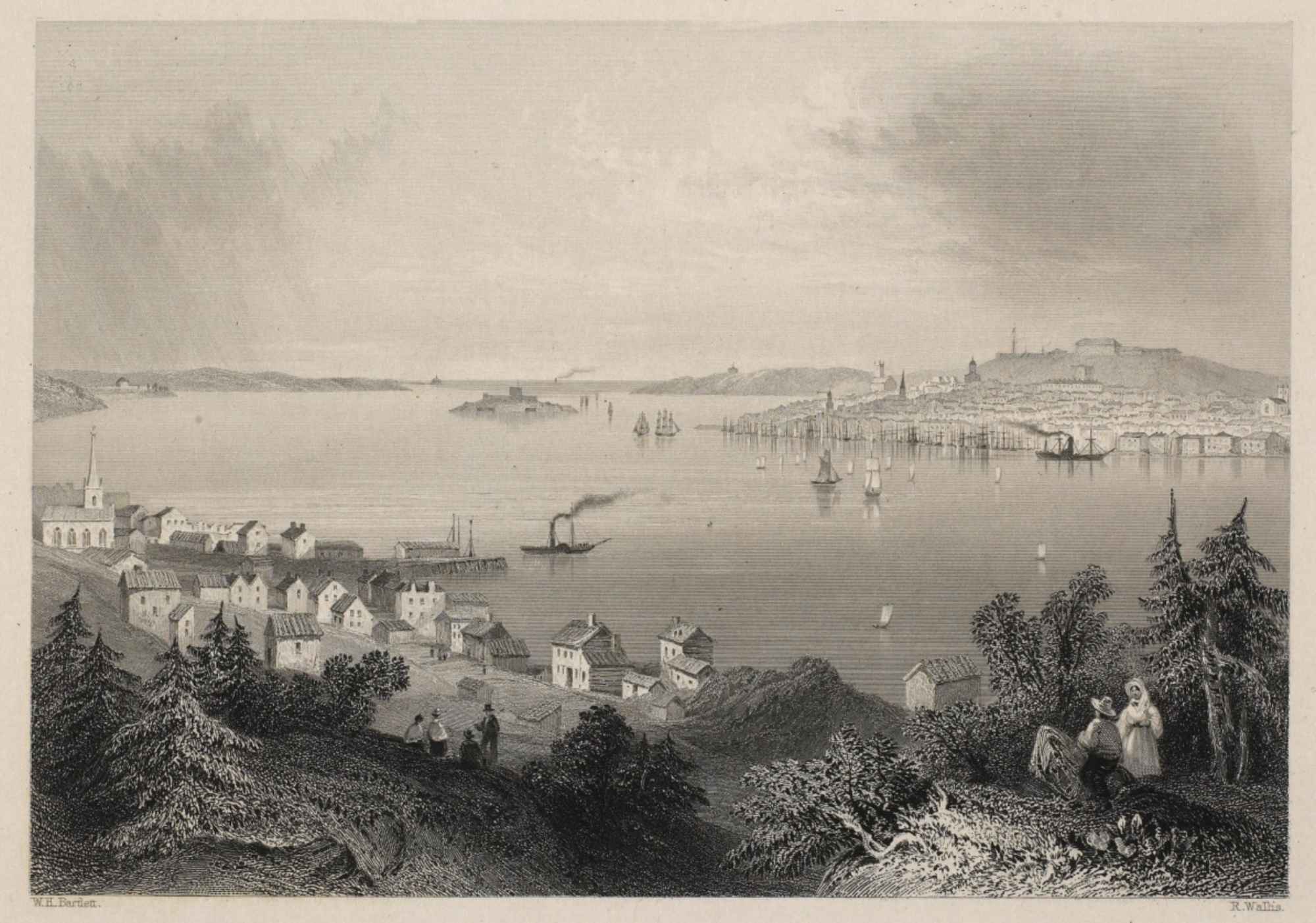Ventes notoires
Halifax from Dartmouth, 1838 (circa)
Oil on canvas
19.5 x 23.5 in
49.5 x 59.7 cm
49.5 x 59.7 cm
Sold
Inscriptions
titled, 'HALIFAX / FROM DARTMOUTH' (lower middle)Provenance
Collection of Senator Michael Pitfield.
Dr. and Mrs. Joe MacInnis, Toronto.
Documentation
Janice Tyrwhitt and Henry C. Campbell, Bartlett’s Canada: A Pre-Confederation Journey (McLelland and Stewart Limited: Toronto, 1968) pp. 12, 16, 19, 22.
William Henry Bartlett (1809-1854) was an early-nineteenth-century English book illustrator, who travelled extensively in Europe, the Middle East, and North America to produce sketches which resulted in the creation of printed illustrations for numerous volumes commissioned by London publishers, most notably George Virtue (1794-1868). Travel books were popular and profitable, and Bartlett achieved considerable fame as an artist for his views, and for the high quality of the printed illustrations after his work which appeared in the many books published by Virtue.
Bartlett visited North America at least four times. From the summer of 1836 to July 1837 he was in the United States sketching sites to illustrate American Scenery by Nathaniel Parker Willis (1806-1867), published in London in 1840. In the summer and fall of 1838 Bartlett was in British North America producing sketches for Willis’s Canadian Scenery, published in London in 1842. Bartlett also returned to North America in 1841, and again in 1852. His North American prints were widely copied by other European and American publishers, notably by Currier & Ives of New York. They also inspired such artists as Edmund Coates, Thomas Chambers, Victor de Grailly and other anonymous artists to paint works based on his subjects. However, these copies in various media remain a source of much confusion, which adds to the complexity of establishing a correct assessment of his original works.
Printmakers employed by publishers preferred working from model images in monochrome rather than in colours, and in a scale suitable to the size of a book. Drawings by Bartlett held in major Canadian collections are consistent with these requirements, as his artistic practice consisted of sketches done in pencil, pen and brush with sepia washes, with very little use of watercolour or paint. George Virtue’s publishing production accounts have never been traced, and little is known as to how Bartlett’s sketches were translated into etchings by other intermediary artists and printmakers.
The exact route of Bartlett’s Canadian journey in 1838 is uncertain, and no supporting documents such as letters or journals have been located. Only the map published in Canadian Scenery shows he traveled from Quebec City to Niagara Falls, before he sailed for England in December 1838. This painting of Halifax from Dartmouth relates to the final plate in Volume II of Canadian Scenery. It is one of the few images fully discussed in the text, and depicts Halifax from the opposite shore, showing its busy harbour and waterfront. Halifax was headquarters to Britain’s North Atlantic Fleet and Dockyard, and as such featured strongly in the maintenance of the Empire.
In contrast to Bartlett’s print, the painting presents a slightly wider perspective, and omits both the figures shown in the foreground of the print, and the steamboat approaching the Dartmouth shore. The luminosity of the sky, the feathery brushwork, the distant vista stretching out into the Atlantic Ocean, and the exaggerated profile of Citadel Hill all combine to make this a particularly attractive work
Jim Burant
—
Jim Burant, a member of the Algonquins of Pikwàkanagàn First Nation, earned his Masters in Canadian Studies specializing in Art History (1979) from Carleton University. He worked at Library and Archives Canada in various capacities, including the management of the art and photography archives, from 1972 until his retirement in April 2011. He has published and lectured widely on aspects of art, photography, and archives in Canada and abroad; has curated many exhibitions; and has an international reputation in the fields of art history and archives. He received the Queen’s Golden Jubilee Medal for his services to Canada in 2003.
Bartlett visited North America at least four times. From the summer of 1836 to July 1837 he was in the United States sketching sites to illustrate American Scenery by Nathaniel Parker Willis (1806-1867), published in London in 1840. In the summer and fall of 1838 Bartlett was in British North America producing sketches for Willis’s Canadian Scenery, published in London in 1842. Bartlett also returned to North America in 1841, and again in 1852. His North American prints were widely copied by other European and American publishers, notably by Currier & Ives of New York. They also inspired such artists as Edmund Coates, Thomas Chambers, Victor de Grailly and other anonymous artists to paint works based on his subjects. However, these copies in various media remain a source of much confusion, which adds to the complexity of establishing a correct assessment of his original works.
Printmakers employed by publishers preferred working from model images in monochrome rather than in colours, and in a scale suitable to the size of a book. Drawings by Bartlett held in major Canadian collections are consistent with these requirements, as his artistic practice consisted of sketches done in pencil, pen and brush with sepia washes, with very little use of watercolour or paint. George Virtue’s publishing production accounts have never been traced, and little is known as to how Bartlett’s sketches were translated into etchings by other intermediary artists and printmakers.
The exact route of Bartlett’s Canadian journey in 1838 is uncertain, and no supporting documents such as letters or journals have been located. Only the map published in Canadian Scenery shows he traveled from Quebec City to Niagara Falls, before he sailed for England in December 1838. This painting of Halifax from Dartmouth relates to the final plate in Volume II of Canadian Scenery. It is one of the few images fully discussed in the text, and depicts Halifax from the opposite shore, showing its busy harbour and waterfront. Halifax was headquarters to Britain’s North Atlantic Fleet and Dockyard, and as such featured strongly in the maintenance of the Empire.
In contrast to Bartlett’s print, the painting presents a slightly wider perspective, and omits both the figures shown in the foreground of the print, and the steamboat approaching the Dartmouth shore. The luminosity of the sky, the feathery brushwork, the distant vista stretching out into the Atlantic Ocean, and the exaggerated profile of Citadel Hill all combine to make this a particularly attractive work
Jim Burant
—
Jim Burant, a member of the Algonquins of Pikwàkanagàn First Nation, earned his Masters in Canadian Studies specializing in Art History (1979) from Carleton University. He worked at Library and Archives Canada in various capacities, including the management of the art and photography archives, from 1972 until his retirement in April 2011. He has published and lectured widely on aspects of art, photography, and archives in Canada and abroad; has curated many exhibitions; and has an international reputation in the fields of art history and archives. He received the Queen’s Golden Jubilee Medal for his services to Canada in 2003.















